The NVIDIA GeForce GTX 1650 Review, Feat. Zotac: Fighting Brute Force With Power Efficiency
by Ryan Smith & Nate Oh on May 3, 2019 10:15 AM ESTFinal Fantasy XV (DX11)
Upon arriving to PC earlier this, Final Fantasy XV: Windows Edition was given a graphical overhaul as it was ported over from console, fruits of their successful partnership with NVIDIA, with hardly any hint of the troubles during Final Fantasy XV's original production and development.
In preparation for the launch, Square Enix opted to release a standalone benchmark that they have since updated. Using the Final Fantasy XV standalone benchmark gives us a lengthy standardized sequence to utilize OCAT. Upon release, the standalone benchmark received criticism for performance issues and general bugginess, as well as confusing graphical presets and performance measurement by 'score'. In its original iteration, the graphical settings could not be adjusted, leaving the user to the presets that were tied to resolution and hidden settings such as GameWorks features.
Since then, Square Enix has patched the benchmark with custom graphics settings and bugfixes to be more accurate in profiling in-game performance and graphical options, though leaving the 'score' measurement. For our testing, we enable or adjust settings to the 'Highest', 'High', or 'Medium' options except for NVIDIA-specific features and 'Model LOD', the latter of which is left at standard. For High, we also turn off the hi-res assets, while for Medium we also turn off 'Geomapping' (terrain tessellation). Final Fantasy XV also supports HDR, and it will support DLSS at some later date.
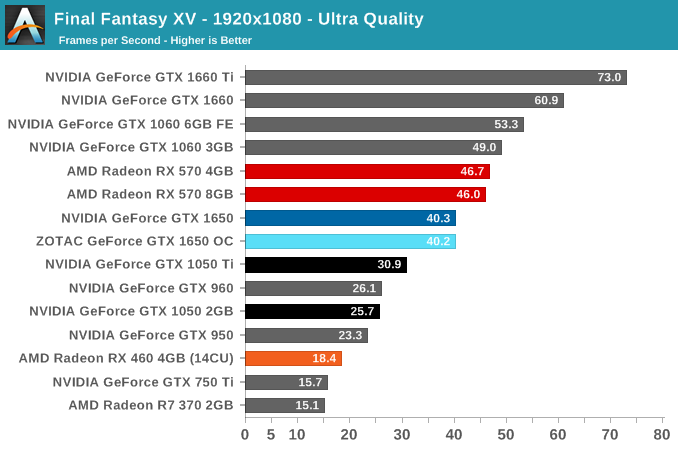
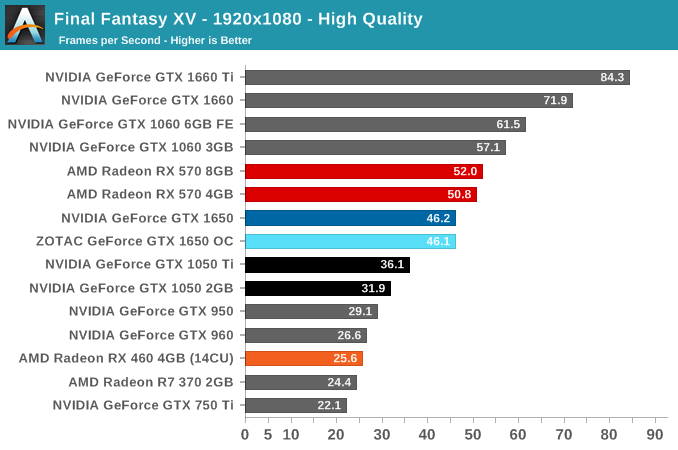
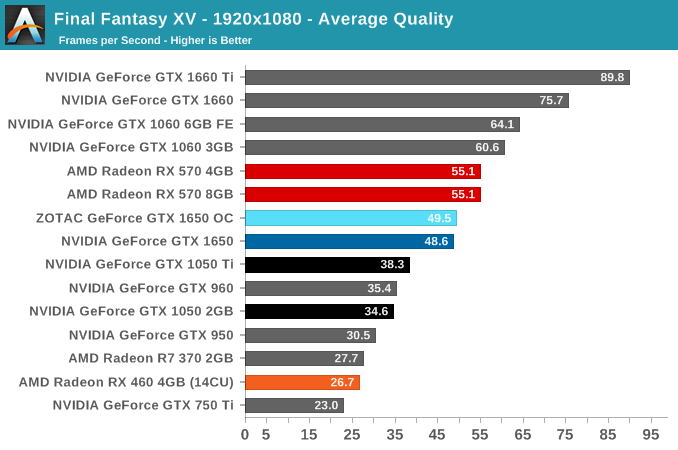
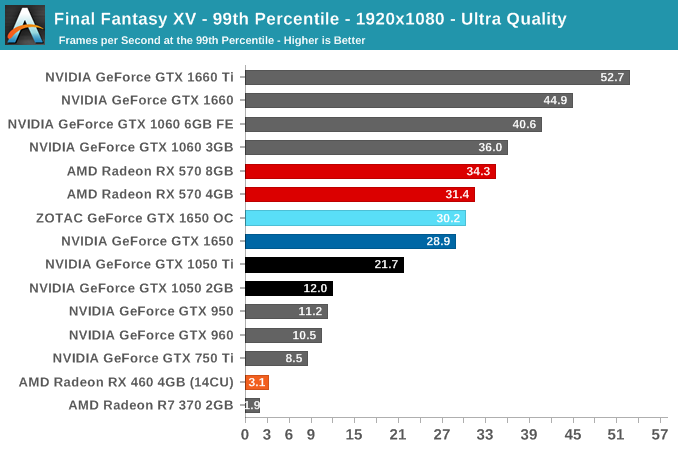
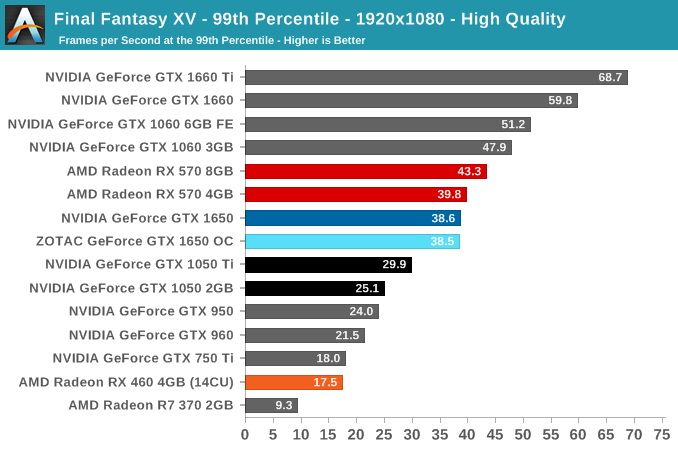
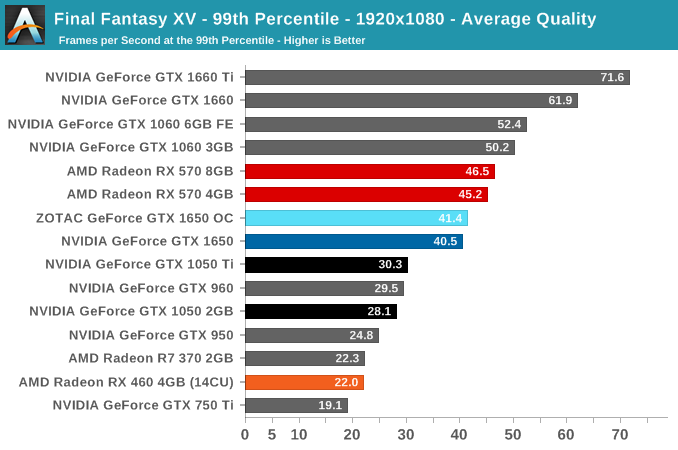
Final Fantasy V is another title that tends to prefer more VRAM, and with ultra settings and high-res textures, all the 2GB cards drop off in their 99th percentiles, reflecting the stuttering experience. The GTX 1650 is almost on par with RX 570 here at the higher settings.











126 Comments
View All Comments
Gigaplex - Sunday, May 5, 2019 - link
I spend more than that on lunch most days.Yojimbo - Sunday, May 5, 2019 - link
"I spend more than that on lunch most days."Economics is hard.
gglaw - Sunday, May 5, 2019 - link
At least you went through and acknowledge how horribly wrong the math was so the entire initial premise is flawed. The $12.50 per year is also very high case scenario that would rarely fit a hardcore gamer who cares about TINY amounts of power savings. This is assuming 3 hours per day, 7 days a week never missing a day of gaming and that every single minute of this computer time is running the GPU at 100%. Even if you twist every number to match your claims it just doesn't pan out - period. The video cards being compared are not $25 difference. Energy conservative adults who care that much about every penny they spend on electricity don't game hardcore 21 hours a week. If you use realistic numbers of 2-3h game time 5 times a week and the fact that the GPU's are not constantly at 100% load and say a more realistic number like 75% of max power usage on average - this results in a value much below the $25 (which again is only half the price difference of the GPU's you're comparing). Using these more realistic numbers it's closer to $8 per year energy cost difference to own a superior card that results in better gaming quality for over a thousand hours. If saving $8 is that big a deal to you to have a lower gaming experience, then you're not really a gamer and probably don't care what card you're running. Just run a 2400G on 720p and low settings and call it a day. Playing the math game with blatantly wrong numbers doesn't validate the value of this card.zodiacfml - Saturday, May 4, 2019 - link
Right. My calculation is a bit higher with $ 0.12 per KWh but playing at 8 hours day, 365 days.I will take the rx570 and undervolt to reduce the consumption.
Yojimbo - Saturday, May 4, 2019 - link
Yes good idea. The you can get the performance of the 1650 for just a few more watts than the 1650.eddieobscurant - Sunday, May 5, 2019 - link
No, it doesn't. It's about 25 dollars over a 2 year period , if you play for 8 hours/day, every day for 2 years. If you're gaming less , or just browsing the difference is way smaller.spdragoo - Monday, May 6, 2019 - link
Per my last bill, I pay $0.0769USD per kWh. So, spending $50USD means I've used 650.195056 kWh, or 650,195.056 Wh. Comparing the power usage at full, it looks like on average you save maybe 80W using the GTX 1650 vs. the RX 570 (75W at full power, 86W at idle, so call it 80W average). That means it takes me (650195.056 Wh / 80W) = 8,127.4382 hours of gaming to have "saved" that much power. In a 2-year period, assuming the average 365.25 days per year & 24 hours per day, there's a maximum available of 17,532 hours. The ratio, then, of the time needed to spend gaming vs. total elapsed time in order to "save" that much power is (8127.4382 / 17352) = 46.838625%...which equates to an average 11.24127 hours (call it 11 hours 15 minutes) of gaming ***per day***. Now, ***MAYBE*** if I a) didn't have to work (or the equivalent, i.e. school) Monday through Friday, b) didn't have some minimum time to be social (i.e. spending time with my spouse), c) didn't have to also take care of chores & errands (mowing the lawn, cleaning the house, grocery shopping, etc.), & d) take the time for other things that also interest me besides PC gaming (reading books, watching movies & TV shows, taking vacations, going to Origins & comic book conventions, etc.), & e) I have someone providing me a roof to live under/food to eat/money to spend on said games & PC, I ****MIGHT**** be able to handle that kind of gaming schedule...but I not only doubt that would happen, but I would probably get very bored & sick of gaming (PC or otherwise) in short order.Even someone who's more of an avid gamer & averages 4 hours of gaming per day, assuming their cost for electricity is the same as mine, will need to wait ***five to six years*** before they can say they saved $50USD on their electrical bill (or the cost of a single AAA game). But let's be honest; even avid gamers of that level are probably not going to be satisfied with a GTX 1650's performance (or even an RX 570's); they're going to want a 1070/1080/1080TI/2060/2070/2080 or similar GPU (depending on their other system specs). Or, the machine rocking the GTX 1650 is their ***secondary*** gaming PC...& since even that is going to set them back a few hundred dollars to build, I seriously doubt they're going to quibble about saving maybe $1 a month on their electrical bill.
Foeketijn - Tuesday, May 7, 2019 - link
You need to game on average 4 hour per day to reach the 50 euro in two years.If gaming is that important to you, you might want to look at another video card.
Hixbot - Tuesday, May 7, 2019 - link
I think performance per watt is an important metric to consider, not because of money saved on electricity but because of less heat dumped into my case.nathanddrews - Friday, May 3, 2019 - link
Yeah, sure seems like it. RX570s have been pretty regularly $120 (4GB) to $150 (8GB) for the last five months. I'm guessing we'll see a 1650SE with 3GB for $109 soon enough (but it won't be labeled as such)...